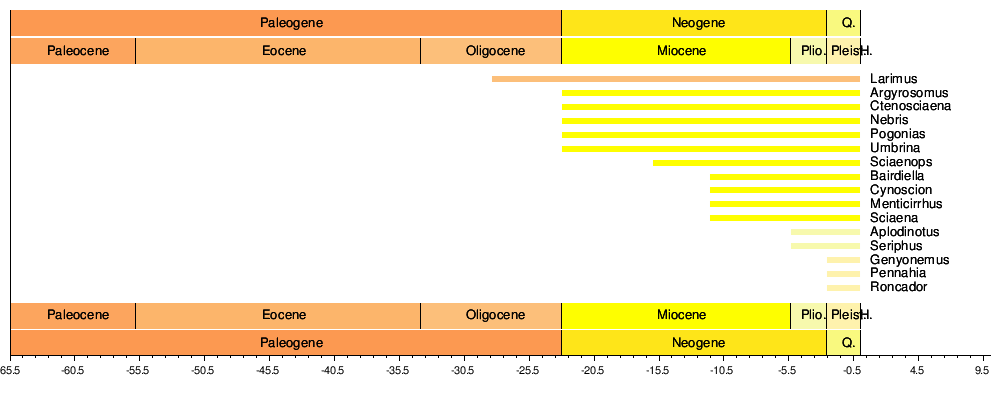Sciaenidae
| Croakers and drums | |
|---|---|
| Atlantic croaker, Micropogonias undulatus | |
| Scientific classification | |
| Kingdom: | Animalia |
| Phylum: | Chordata |
| Class: | Actinopterygii |
| Order: | Perciformes |
| Suborder: | Percoidei |
| Family: | Sciaenidae |
| Genera | |
|
See text. |
|
Sciaenidae is a family of fish commonly called drums, croakers, or hardheads for the repetitive throbbing or drumming sounds they make. The family includes the weakfish, and consists of about 275 species in about 70 genera; it belongs to the order Perciformes.
Sciaenids have a long dorsal fin reaching nearly to the tail, and a notch between the rays and spines of the dorsal, although the two parts are actually separate.[1] Drums are somberly colored, usually in shades of brown, with a lateral line that extends to the tip of the caudal fin. The anal fin usually has two spines while the dorsal fins are deeply notched or separate. Most species have a rounded or pointed caudal fin. The mouth is set low and is usually inferior.
They are found worldwide, in both fresh and saltwater, and are typically benthic carnivores, feeding on invertebrates and smaller fish. They are small to medium-sized bottom dwelling fishes that live primarily in estuaries, bays, and muddy river banks. Most of these fishes avoid clear waters such as coral reefs and oceanic islands with a few notable exceptions (i.e., Reef Croaker, High-hat, and Spotted Drum). They live in warm-temperate and tropical waters and are best represented in major rivers in S.E. Asia, Plymouth UK, N.E. South America, Gulf of Mexico, and Gulf of California.[1]
They are excellent food and sport fish and are commonly caught by surf and pier fishers.
The croaking mechanism involves the beating of abdominal muscles against the swim bladder.[1]
Genera and selected species
- Aplodinotus: Freshwater drum
- Argyrosomus: Meagre, Mulloway
- Aspericorvina
- Atractoscion: White seabass
- Atrobucca
- Austronibea
- Bahaba
- Bairdiella
- Boesemania
- Cheilotrema
- Chrysochir
- Cilus
- Collichthys
- Corvula
- Ctenosciaena
- Cynoscion: Weakfish, Acoupa weakfish, Spotted seatrout
- Daysciaena
- Dendrophysa
- Elattarchus
- Equetus
- Genyonemus: White croaker
- Isopisthus
- Johnius
- Kathala
- Larimichthys
- Larimus
- Leiostomus: Spot croaker
- Lonchurus
- Macrodon
- Macrospinosa
- Megalonibea
- Menticirrhus: Kingcroaker, California corbina
- Micropogonias
- Miichthys
- Miracorvina
- Nebris
- Nibea
- Odontoscion
- Ophioscion
- Otolithes
- Otolithoides
- Pachypops
- Pachyurus
- Panna
- Paralonchurus
- Paranibea
- Pareques
- Pennahia
- Pentheroscion
- Plagioscion
- Pogonias: Black Drum
- Protonibea
- Protosciaena
- Pseudosciaena
- Pseudotolithus
- Pteroscion
- Pterotolithus
- Roncador: Spotfin croaker
- Sciaena umbra: Brown meagre
- Sciaenops: Red drum
- Seriphus: Queenfish
- Sonorolux
- Stellifer
- Totoaba
- Umbrina: Yellowfin croaker
Timeline of genera

References
- Froese, Rainer, and Daniel Pauly, eds. (2006). "Sciaenidae" in FishBase. May 2006 version.
- Sepkoski, Jack (2002). "A compendium of fossil marine animal genera". Bulletins of American Paleontology 364: p.560. http://strata.ummp.lsa.umich.edu/jack/showgenera.php?taxon=611&rank=class. Retrieved 2011-05-19.